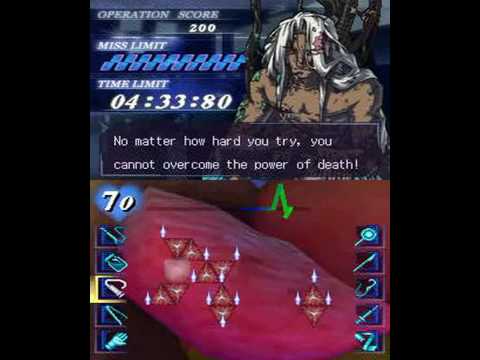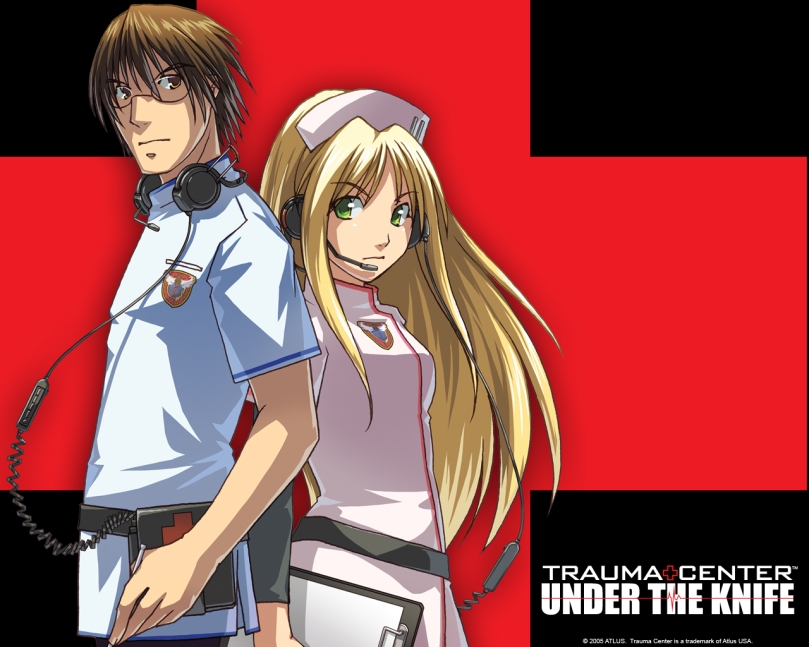I like to think I can be one of those ad-hoc surgeons they find in an emergency say on a plane after playing Trauma Center, but unfortunately I don’t have any of the surgical tools they conveniently provide for every operation in the game, so I won’t be operating on anyone anytime soon. Also, there is just the possibility that there won’t be dotted lines for me to trace on an actual human body, but let’s not think of the worst case scenarios, shall we?
This is the first time I’ve played any game in the Trauma Center series. This is a DS game, and for those unfamiliar with the capabilities of the DS, it has 2 screens, the bottom of which is touchscreen. You can probably guess which is the screen the operations are performed on. Using the stylus, you perform a variety of tasks related to cutting a person open, burning their parts with laser and frantically trying to salvage their rapidly declining vitals before they, you know, die have to be saved by a presumably more expert team of doctors.
Something I like about Trauma Center is that each operation is kept short, with a maximum time limit of 5 minutes per operation. This means that as the game progresses, the difficulty level cannot be increased by simply making operations longer and more tedious — it forces level designers to condense their design and think of more creative ways to sustain interest.
There’s an obvious pattern in the game, where an operation where they teach you new techniques is followed by a few similar operations where they don’t give you guidance. This is largely enjoyable, allowing the player to feel a growing sense of mastery, especially when operations in later chapters develop these techniques further.
The learning process itself, however, is frustrating. Learning comes in the form of your very own personal nurse (obviously female and pretty), who delivers instructions in condensed one liners. These one liners are often not comprehended by me. At the start of the game it was more often “Use the suture and stitch him back up”, which was confusing as all the tools were just silhouettes on the sides of the screen. As the game progresses and I get a better knowledge of which tools are called what, the designers have introduced tasks with strategic elements which are explained poorly perhaps because of their brevity, causing me to have to turn to walkthroughs just to get a better understanding of what was said.

Another frustration is that the delivery of the one-liners can sometimes be in the middle of the operation, which pauses time and resets the tool you are holding, and which you have to press a button in order to progress past. Since my fingers are wrapped around my stylus, it breaks the flow of the game to have to press a physical button; I’d have preferred a virtual button on the screen.
Certain operations are also not fun to go through. For example, the stage I am currently stuck at has me trying to remove “Triti” patches from a patient’s organ — except these patches keep re-growing. This race for speed turns out to be quite a chore as I find myself removing the same patches, over and over again.

Digressing from the game design to talk about the sociological slant — the main character of the game is a male doctor who starts off as being a complete slacker, ignorant of what to do and careless in his treatment. At every point of the game he is guided by a female companion, who is often a nurse. Perhaps one of the most ridiculous points of the story was when there was a bomb threat, and his fellow female doctor decides they should be the heroes to detonate the bomb — she assures him that her knowledge of bomb detonation is sound, then orders him to do the job while she assists from the side. Story-wise, it makes no sense that these female companions have superior knowledge of the operations, but end up merely assisting instead of carrying out the work themselves. Like a certain remake of Harry Potter starring Hermione as the main character, the main character in this case seems to have gotten to where he is from pure privilege… But I’m probably opening myself up to rape threats from #gamergaters.
“They ruin everything!!!”
Nevertheless, I am enjoying the game, with its many uses of the stylus on the touchscreen, as well as the story segments which provide a refreshing break in between operations.


So, this is the game that you mentioned before. I just searched for the gameplay video and I cannot watch further.(I simply cannot watch those scenes even if it’s not a real..) You pointed out some goof and errors they made on this game and it sounds weird to me either. Thanks for letting me know this game anyway. Thanks
I feel the issue is with interface design rather than mechanics/dialogue. A simple glow around the icon when a tool is first introduced would seem to solve most of the issues you describe.
The highlight is that video games are just models of reality. They can provide a way to experience the unexperienceable, but it will never be the same; only in games can stereotypes be highly emphasized and activities made more exciting. Surgeons don’t have a hard time limit; the patient goes when the patient goes.
Then again, since video games are just models, they provide simulation training where it would be impossible or expensive to conduct live training many times over. Just because you played a DS game that badly simulates surgery doesn’t mean there isn’t one developed proprietarily for medical students. Video games/digital simulations would help a lot in vocational education as well.
Lol Sam, I wasn’t expecting to actually perform surgery from this game! All my jibes were tongue-in-cheek. Obviously video games aren’t simulations, they would suck if they were…
But yes, I think the problems I pointed out can be solved by UI and clearer elucidation. I realize I forgot an important thing the game doesn’t do as well: it doesn’t guide you towards how to better do procedures. They give you ratings on how well the operation went, and also after every action they would have feedback of “bad”, “cool”, or “good”, but they don’t tell you how they determine what is what.
Nice review and thoughts on the Trauma Center game. You asked yourself what you liked and don’t liked about the game. Then you went on to analyze why you didn’t like the game i.e the one-liners, unclear instructions and sometimes repetitive tasks. I have not played the game myself, but I can see why these are frustrations or unwelcome elements to the game. The next question I think would be great to explore is why did the developers choose to leave such elements? Is there another reason why the tools are vague or the instructions unclear? Maybe the developers wanted more challenge? Or did they want to teach their guests about the instruments of doctors through trial and error? Either way, these would be some interesting questions to further explore or ask yourself if you continue to play the game! Thanks for the post Melody